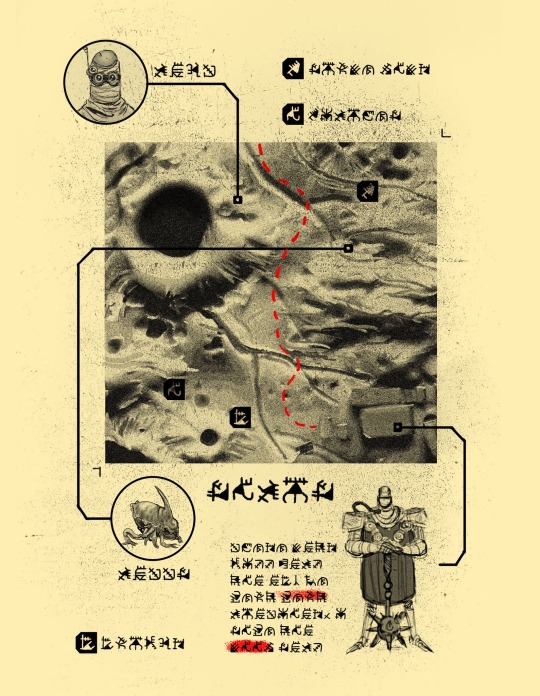#topology
Text
Introduction to Topology Master Post
Metric Spaces
Topological Spaces and Continuity
Closed Sets and Limit Points
Hausdorffness
Connectedness
Path Connectedness
Compactness
Bases and Second Countability
Product Spaces
The Heine-Borel Theorem
Quotient Spaces
Important Examples
Conclusions and Remaining Questions
As of making this post, the entire series isn't out yet so some links won't be here yet (24/04/2024)
37 notes
·
View notes
Text
You guys are never gonna believe what the name of this sculpture is


24K notes
·
View notes
Text
Math
Geologist: I do more math than you might think
Chemist: I mean, chemical equations are basically mathematical equations. If you think about it (I also do math math)
Physicist: Oh, yeah, it’s all math but we just handwave it
Mathematician: YOU DO WHAT!?
Quantum Physicist: *regularly does math that is literally beyond human comprehension* *now resides in a higher plane of existence*
Engineer: If I don’t do this math correctly PEOPLE WILL DIE
Military Scientist: If I don’t do this math correctly PEOPLE WILL SURVIVE
Topologist: If I don’t do this math correctly PEOPLE WILL BE MOSTLY UNAFFECTED
Philosopher: But what even IS math, really? No seriously, what is it?
Organic Chemist: I kinda forgot how to do math, to be honest
Biologist: I literally only chose this field so I wouldn’t have to do as much math. I love stamp collecting
Biostatistician: wtf
#science#biology#physics#chemistry#geology#scientists sitcom#why tf do I need a calculus credit for a bachelors of biology degree???#astronomy#engineering#math#military science#topology#biostatistics
1K notes
·
View notes
Text

I don't understand how lace is made, but looking at the bobbins and pins and patterns … listen buddy I know math when I see it. This is A Math Thing. Obviously.

Right away I want to know:
Can I encode information in lace?
How much of an expert must one be to make your own patterns?
What about the creation of surfaces?
Knitting is more accessible, and people have been exploring math with knitting forever.
But what possibilities does lace offer?
What is the theory of lace?

An excerpt from Mathematics Magazine
Vol. 91, No. 4 (October 2018), pp. 307-309
Shows I'm hardly the first person to muse about this. Need to get my hands on the rest of this article, obviously.
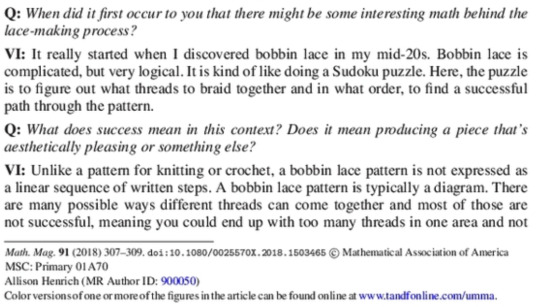
#crafts#crafting#making#lace#lacemaking#knitting#mathematics#topology#geometry#bobbin lace#tatted lace#tatting#complexity#patterns#industrial revolution
1K notes
·
View notes
Text

IM SO MAD THEY FUCKED UP ITS EULER CHARACTERISTIC HOW AM I SUPPOSED TO DRINK THIS
508 notes
·
View notes
Text
Blorbo from my math papers

Source - Using Surfaces to solve equations in free groups, M. Culler 1981
https://doi.org/10.1016/0040-9383(81)90033-1
2K notes
·
View notes
Text
Therapist: Klein bottle chess isn't real, klein bottle chess can't hurt you
Klein bottle chess:
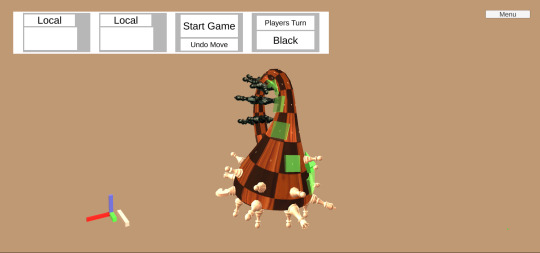
#chess#chessboard#chess variants#3d chess#5d chess#5d chess with multiverse time travel#time travel chess#klein bottle#topology#topological#maths#math#mathblr#codeblr#progblr#unity3d#gamedev#mathematics#programming#game development
444 notes
·
View notes
Text
Physicists have just found something no one expected, lurking on the surface of an arsenic crystal.
While undertaking a study of quantum topology – the wave-like behavior of particles combined with the mathematics of geometry – a team found a strange hybrid of two quantum states, each describing a different means of current.
"This finding was completely unexpected," says physicist M. Zahid Hasan of Princeton University. "Nobody predicted it in theory before its observation."
Continue Reading.
82 notes
·
View notes
Text
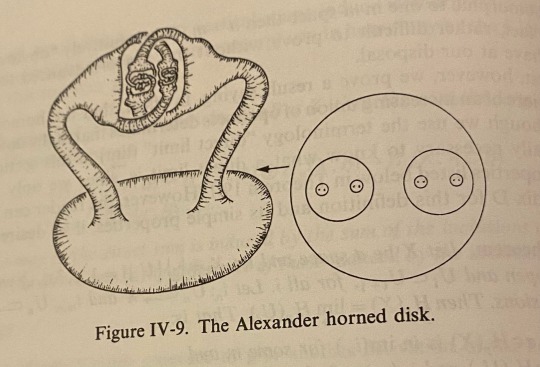
There he is. There’s my boy!!!
126 notes
·
View notes
Text
you should always remember that no matter how bad a knot is, it's still just a circle
--speaker at a topology conference
72 notes
·
View notes
Text
Mathematician trying to write a romance novel: "there exists no open set containing one but not the other"
898 notes
·
View notes
Text
i helped* write a new physics textbook and it has a cool (and free) website: softmatterbook.online
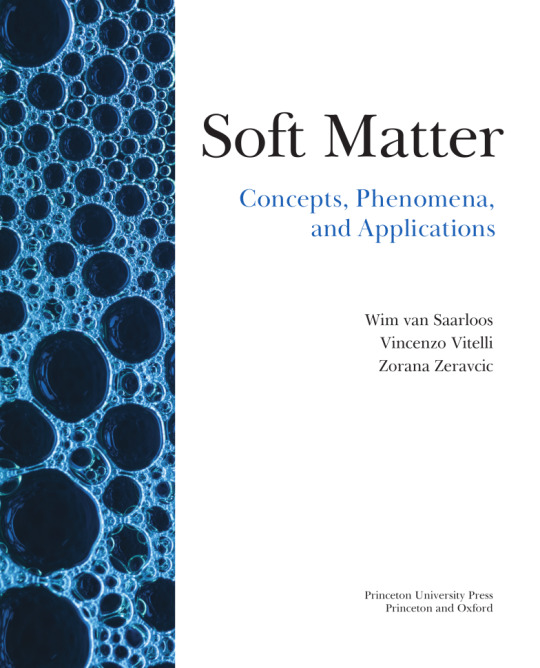
*a little bit. The vast majority of the book was written by van Saarloos, Vitelli, and Zeravcic, but a whole bunch of people contributed little bits of writing (myself included) and are credited in the preface.
This book is an accumulation of some of the most fundamental results in soft matter physics, many of which were first discovered or derived very recently. The website hosts a bunch of extra resources (videos, notes, demos, etc.) sorted by the chapters of the book:
Fluid Dynamics
Elasticity
Brownian Motion
Colloids
Polymers
Liquid Crystals
Interfaces, Surfaces, & Membranes
Pattern Formation out of Equilibrium
Active Matter
From Designing Matter to Mimicking Life
It also lists a whole bunch of labs all around the world that are studying the sorts of systems described in the book, as well as mailing lists you can sign up for, conferences, workshops, youtube channels, and software packages. I'm absolutely biased (see below) but I think it's a really great resource for anybody interested in soft matter!
I spent the first year of my PhD helping to put this thing together. I translated research papers into problems, hunted for typos, and wrote most of the solutions in the instructor's manual. I don't make any money off the book sales (my PI told me they made it available for as cheap of a price as the publisher would allow), but my PhD stipend was funded for the year to work on this thing instead of having to TA.
I was ridiculously lucky to get the chance to work on this thing, even if at times it felt like learning how the academic sausage gets made.
77 notes
·
View notes
Text
Welcome to the premier of One-Picture-Proof!

This is either going to be the first installment of a long running series or something I will never do again. (We'll see, don't know yet.)
Like the name suggests each iteration will showcase a theorem with its proof, all in one picture. I will provide preliminaries and definitions, as well as some execises so you can test your understanding. (Answers will be provided below the break.)
The goal is to ease people with some basic knowledge in mathematics into set theory, and its categorical approach specifically. While many of the theorems in this series will apply to topos theory in general, our main interest will be the topos Set. I will assume you are aware of the notations of commutative diagrams and some terminology. You will find each post to be very information dense, don't feel discouraged if you need some time on each diagram. When you have internalized everything mentioned in this post you have completed weeks worth of study from a variety of undergrad and grad courses. Try to work through the proof arrow by arrow, try out specific examples and it will become clear in retrospect.
Please feel free to submit your solutions and ask questions, I will try to clear up missunderstandings and it will help me designing further illustrations. (Of course you can just cheat, but where's the fun in that. Noone's here to judge you!)
Preliminaries and Definitions:
B^A is the exponential object, which contains all morphisms A→B. I comes equipped with the morphism eval. : A×(B^A)→B which can be thought of as evaluating an input-morphism pair (a,f)↦f(a).
The natural isomorphism curry sends a morphism X×A→B to the morphism X→B^A that partially evaluates it. (1×A≃A)
φ is just some morphism A→B^A.
Δ is the diagonal, which maps a↦(a,a).
1 is the terminal object, you can think of it as a single-point set.
We will start out with some introductory theorem, which many of you may already be familiar with. Here it is again, so you don't have to scroll all the way up:

Exercises:
What is the statement of the theorem?
Work through the proof, follow the arrows in the diagram, understand how it is composed.
What is the more popular name for this technique?
What are some applications of it? Work through those corollaries in the diagram.
Can the theorem be modified for epimorphisms? Why or why not?
For the advanced: What is the precise requirement on the category, such that we can perform this proof?
For the advanced: Can you alter the proof to lessen this requirement?
Bonus question: Can you see the Sicko face? Can you unsee it now?
Expand to see the solutions:
Solutions:
This is Lawvere's Fixed-Point Theorem. It states that, if there is a point-surjective morphism φ:A→B^A, then every endomorphism on B has a fixed point.
Good job! Nothing else to say here.
This is most commonly known as diagonalization, though many corollaries carry their own name. Usually it is stated in its contraposition: Given a fixed-point-less endomorphism on B there is no surjective morphism A→B^A.
Most famous is certainly Cantor's Diagonalization, which introduced the technique and founded the field of set theory. For this we work in the category of sets where morphisms are functions. Let A=ℕ and B=2={0,1}. Now the function 2→2, 0↦1, 1↦0 witnesses that there can not be a surjection ℕ→2^ℕ, and thus there is more than one infinite cardinal. Similarly it is also the prototypiacal proof of incompletness arguments, such as Gödels Incompleteness Theorem when applied to a Gödel-numbering, the Halting Problem when we enumerate all programs (more generally Rice's Theorem), Russells Paradox, the Liar Paradox and Tarski's Non-Defineability of Truth when we enumerate definable formulas or Curry's Paradox which shows lambda calculus is incompatible with the implication symbol (minimal logic) as well as many many more. As in the proof for Curry's Paradox it can be used to construct a fixed-point combinator. It also is the basis for forcing but this will be discussed in detail at a later date.
If we were to replace point-surjective with epimorphism the theorem would no longer hold for general categories. (Of course in Set the epimorphisms are exactly the surjective functions.) The standard counterexample is somewhat technical and uses an epimorphism ℕ→S^ℕ in the category of compactly generated Hausdorff spaces. This either made it very obvious to you or not at all. Either way, don't linger on this for too long. (Maybe in future installments we will talk about Polish spaces, then you may want to look at this again.) If you really want to you can read more in the nLab page mentioned below.
This proof requires our category to be cartesian closed. This means that it has all finite products and gives us some "meta knowledge", called closed monoidal structure, to work with exponentials.
Yanofsky's theorem is a slight generalization. It combines our proof steps where we use the closed monoidal structure such that we only use finite products by pre-evaluating everything. But this in turn requires us to introduce a corresponding technicallity to the statement of the theorem which makes working with it much more cumbersome. So it is worth keeping in the back of your mind that it exists, but usually you want to be working with Lawvere's version.
Yes you can. No, you will never be able to look at this diagram the same way again.
We see that Lawvere's Theorem forms the foundation of foundational mathematics and logic, appears everywhere and is (imo) its most important theorem. Hence why I thought it a good pick to kick of this series.
If you want to read more, the nLab page expands on some of the only tangentially mentioned topics, but in my opinion this suprisingly beginner friendly paper by Yanofsky is the best way to read about the topic.
#mathblr#mathematics#set theory#diagram#topos theory#diagonalization#topology#incompleteness#logic#nLab#Lawvere#fixed point#theorem#teaching#paradox#halting problem#math#phdblr#Yanofsky#Cantor#Tarski#Gödel#Russell#philosophy#category theory
71 notes
·
View notes


